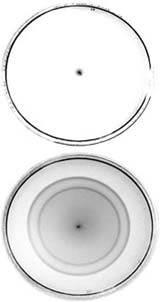Switch makes Salmonella stick or twist

FimZ is the difference between Salmonella sticking(top) or swimming (bottom) <br>© S. Clegg <br>
Drug leads in protein that sends gut bacteria packing
A protein enables harmful Salmonella bacteria to switch from clinging to our gut lining to swimming off. This get-up-and-go is so crucial to Salmonella’s survival that the protein could prove to be a good target for drugs.
The Salmonella variant Typhimurium causes around 1.4 million cases of food poisoning in the United States each year, and about 1,000 deaths – mainly among infants and the elderly. The bug grips the gut wall to cause infection, and swims off to avoid immune-system attacks or to infect another host.
Steven Clegg at the University of Iowa in Iowa City and Kelly Hughes at the University of Washington in Seattle find that letting go is hard to do if the bacterium produces too much of a protein called FimZ.
This protein makes the bacterium grow sticky filaments, called fimbriae, which lash it to the gut lining. When FimZ production is switched off, the bacteria instead make smooth hairs called flagella. Spinning like propellers, these move the bugs around.
Mutant bacteria that produce too much FimZ cannot budge, even in conditions that normally send them packing, Clegg and Hughes report. Conversely, forcing the bugs to make too little of the protein could stop them sticking to surfaces, the researchers hope.
“It’s a very promising angle of attack,” says Ian Blomfield, who studies gut bacteria at the University of Kent in Canterbury, UK. He has identified a similar molecular switch in highly infectious Escherichia coli bacteria, which he is patenting as a potential drug target.
Inside out
Clegg and Hughes suspect that FimZ is half of a two-component system. Many bacteria use such protein pairs to sense their surroundings.
Disrupting FimZ production inside Salmonella may be enough to stop the microbes in their tracks. But blocking the other protein, which sits on the outside of the bacteria, might work even better. This would blind a bug to the subtle chemical cues that tell it whether to stay or go.
“If you can knock out that molecule, the bacteria won’t be able to interact with their environment,” says Clegg. He hopes that more cellular sleuthing will identify the external molecule, which is a tempting target for future drugs or vaccines.
References
- Clegg, S. & Hughes, K. T. FimZ is a molecular link between sticking and swimming in Salmonella enterica serovar Typhimurium. Journal of Bacteriology, 184, 1209 – 1213, (2002).
Media Contact
All latest news from the category: Health and Medicine
This subject area encompasses research and studies in the field of human medicine.
Among the wide-ranging list of topics covered here are anesthesiology, anatomy, surgery, human genetics, hygiene and environmental medicine, internal medicine, neurology, pharmacology, physiology, urology and dental medicine.
Newest articles

A ‘language’ for ML models to predict nanopore properties
A large number of 2D materials like graphene can have nanopores – small holes formed by missing atoms through which foreign substances can pass. The properties of these nanopores dictate many…

Clinically validated, wearable ultrasound patch
… for continuous blood pressure monitoring. A team of researchers at the University of California San Diego has developed a new and improved wearable ultrasound patch for continuous and noninvasive…

A new puzzle piece for string theory research
Dr. Ksenia Fedosova from the Cluster of Excellence Mathematics Münster, along with an international research team, has proven a conjecture in string theory that physicists had proposed regarding certain equations….



